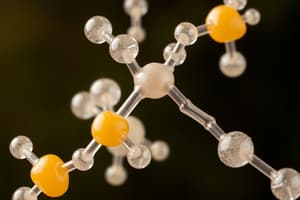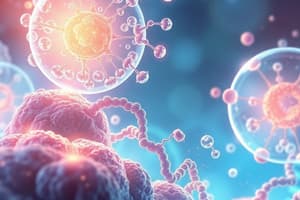Podcast
Questions and Answers
What are the main distinctions between monosaccharides, disaccharides, and polysaccharides?
What are the main distinctions between monosaccharides, disaccharides, and polysaccharides?
Monosaccharides are single sugar units, disaccharides consist of two monosaccharides linked together, and polysaccharides are long chains of monosaccharides.
Define D- and L- isomerism in carbohydrates and give an example of each.
Define D- and L- isomerism in carbohydrates and give an example of each.
D- and L- isomerism refers to the spatial arrangement of hydroxyl groups around the asymmetric carbon. An example of a D-isomer is D-glucose, while L-glucose exemplifies an L-isomer.
Explain the terms 'epimers' and 'anomers' in the context of carbohydrate structure.
Explain the terms 'epimers' and 'anomers' in the context of carbohydrate structure.
Epimers are sugars that differ at only one specific carbon atom, while anomers are a type of epimer that differ at the anomeric carbon (C1) when in cyclic form.
How do carbohydrates function as fuel and structural molecules in biological systems?
How do carbohydrates function as fuel and structural molecules in biological systems?
What role do carbohydrates play as antigens and in cell recognition?
What role do carbohydrates play as antigens and in cell recognition?
Flashcards
Monosaccharides
Monosaccharides
Simple sugars that are the basic building blocks of carbohydrates. They cannot be broken down into smaller sugars.
Disaccharides
Disaccharides
Sugar molecules made up of two monosaccharides joined together. Examples include sucrose (table sugar), lactose (milk sugar) and maltose.
Polysaccharides
Polysaccharides
Complex carbohydrates made up of many monosaccharides linked together in long chains. Examples include starch, glycogen, cellulose and chitin.
D- and L- Isomerism
D- and L- Isomerism
Signup and view all the flashcards
Epimers
Epimers
Signup and view all the flashcards
Study Notes
Unit 3: Biochemistry of Carbohydrates
- This unit covers the introduction and classification of carbohydrates.
- It includes monosaccharides, disaccharides, and polysaccharides (glycogen, starch, cellulose, and chitin).
- D- and L- isomerism, epimers, and anomers are key concepts to understand.
- Carbohydrates are important as fuel and structural molecules.
- Carbohydrates also play a role in antigens and cell recognition.
Studying That Suits You
Use AI to generate personalized quizzes and flashcards to suit your learning preferences.




